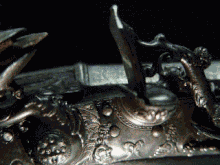Snaphance

A snaphance or snaphaunce is a type of
The name is Dutch in origin but the mechanism cannot be attributed to the Netherlands with certainty.
Examples of this firearm can be found in Europe, North Africa, and the Middle East.
Design

Like the earlier snaplock and later flintlock, the snaphance drives flint onto steel to create a shower of sparks to ignite the priming powder in the pan, the flash partly passing through the touch hole into the barrel where it ignites the main charge (propellant).
The flint is held in a clamp at the end of a bent lever called the cock. Upon pulling the trigger, this moves forward under the pressure of a strong spring and strikes a curved plate of hardened steel (called simply the steel, or in 17th century English dialect the frizzen) to produce a shower of sparks (actually white-hot steel shavings). These fall into a flash pan holding priming powder. The flash from the pan travels through the touch hole to cause the main charge of gunpowder to explode. The steel is at the end of an arm that can be moved independently of the pan cover.
The snaphance first appeared in the late 1550s as an improvement of the earlier
Use
The snaphance was used from the mid 16th century, most commonly in pistol form as a weapon for officers and cavalry. It was used alongside the inferior wheellock in the 16th and 17th centuries, with different countries favoring different mechanisms. James Turners' Pallas Armata, written in the 1630s, noted that the snaphance (and other flintlocks) reigned supreme among cavalry in France, Britain, and the Dutch Republic, while the wheellock was still more common in the German lands: "The French use locks with half bends (snaphaunces), and so do for the most part the English and Scots; the Germans rore or wheel-locks; the Hollanders make use of both."
Fragility, complexity, and cost kept it from replacing the matchlock in the hands of infantry, though the latter issue became less prominent as technology improved. By 1645 a matchlock musket cost 10 shillings in Britain compared to 15 shillings for a flintlock musket. However, flintlocks were still much cheaper than wheellocks; in 1631 the Royal Armoury's purchase records show the going rate as 3 pounds (60 shillings) for a pair of wheellock pistols versus 2 pounds (40 shillings) for a pair of flintlock pistols.[3]
By about 1680, it was gradually superseded and was still occasionally issued to reinforcements for Portugal for the British Army in the Wars of the Spanish Succession of 1703 and in Northern Italy where it was still in use until the 1750s. In Europe, and especially France, the snaphance was replaced by the
The snaphance dominated the New England gun market until it fell out of favor in the middle of the 17th century. Virginia, Massachusetts, and Connecticut outlawed the outdated mechanism by the late 17th century.[4]
Name
The origin of the name snaphance is thought to come from the Dutch Snaphaan, which roughly means "pecking rooster" and relates to the shape of the mechanism and its downward-darting action (and would also explain the name "cock" for the beak-shaped mechanism which holds the flint). In German, the calque Schnapphahn moved away from the earlier definitions and has traditionally referred to a mounted highwayman, who would have been likely to use a firearm of that nature. The French chenapan also changed its meaning in the seventeenth century to define a rogue or scoundrel. During the Second Northern and Scanian Wars, a "Snapphane" was a pro-Danish Guerilla-man in Scania, which had just been annexed by Sweden, as they wanted to belong to Denmark instead.
In Swedish the word Snapphane is first recorded 1558 in a letter from
See also
- Caplock mechanism
- Flintlock
- Hand cannon
- Matchlock
- Miquelet
- Percussion cap
- Snaplock
- Wheellock
- Doglock
References
- ^ Godwin, Brian. "Brian Godwin on The English Snaphance". Archived from the original on 12 August 2013. Retrieved 26 November 2012.
- ^ ISBN 9780486421612. Retrieved 26 November 2012.
Snaphance.
- ^ Keith Dowen. "Arms and Armour of the English Civil Wars." Royal Armouries 2019. Pages 45 and 68
- ISBN 978-0486436814.
Brian Godwin, The English Snaphance Lock, London Park Lane Arms Fair catalog, Spring 2006, and Classic Arms and Militaria Magazine, volume XVI Issue 1, page 48




